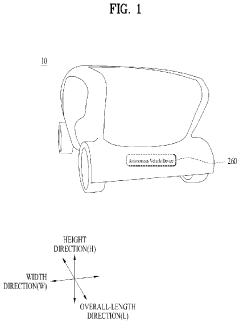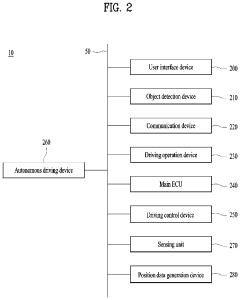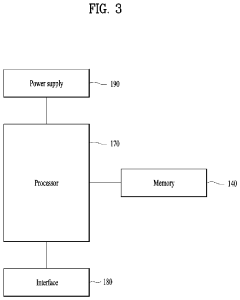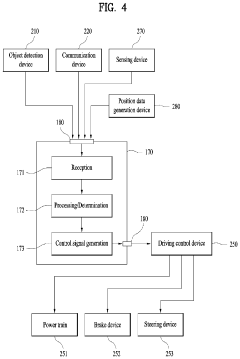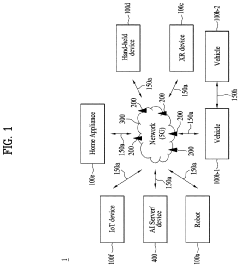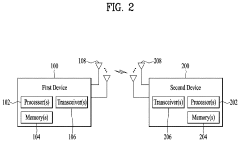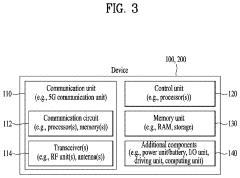How 5G UC Supports High-Quality Video Streaming Services
JUL 18, 20258 MIN READ
Generate Your Research Report Instantly with AI Agent
Patsnap Eureka helps you evaluate technical feasibility & market potential.
5G UC Video Streaming Background and Objectives
The evolution of mobile networks has been a journey of continuous improvement, with each generation bringing significant advancements in speed, capacity, and reliability. The advent of 5G technology marks a pivotal moment in this progression, particularly in the realm of video streaming services. 5G UC (Ultra Capacity) represents a cutting-edge implementation of 5G technology, designed to deliver enhanced performance and capabilities.
The primary objective of 5G UC in supporting high-quality video streaming services is to address the growing demand for seamless, high-definition video experiences across various platforms and devices. As consumer expectations for video quality continue to rise, coupled with the proliferation of streaming services and user-generated content, the need for robust network infrastructure becomes increasingly critical.
5G UC aims to overcome the limitations of previous generations by providing significantly higher bandwidth, lower latency, and improved network reliability. These features are essential for supporting the transmission of high-resolution video content, including 4K and 8K streams, as well as emerging technologies such as virtual reality (VR) and augmented reality (AR) video applications.
The development of 5G UC technology is driven by several key factors. First, the exponential growth in video traffic, which is projected to account for over 80% of all internet traffic by 2022. Second, the increasing adoption of mobile devices as primary platforms for video consumption. Third, the rising popularity of live streaming and interactive video content, which demand real-time, high-quality transmission capabilities.
From a technical perspective, 5G UC leverages advanced spectrum utilization techniques, massive MIMO (Multiple-Input Multiple-Output) antenna systems, and network slicing to achieve its performance goals. These technologies work in concert to provide the necessary infrastructure for delivering consistent, high-quality video streams to a large number of simultaneous users.
The implementation of 5G UC for video streaming services is expected to revolutionize various industries beyond entertainment. In healthcare, it could enable remote medical consultations with high-definition video quality. In education, it could facilitate immersive distance learning experiences. For businesses, it could enhance video conferencing capabilities, making remote collaboration more effective and engaging.
As we explore the potential of 5G UC in supporting high-quality video streaming services, it is crucial to consider both the technological advancements and the evolving market demands. This technology not only promises to enhance the user experience but also opens up new possibilities for content creation, distribution, and consumption in the digital age.
The primary objective of 5G UC in supporting high-quality video streaming services is to address the growing demand for seamless, high-definition video experiences across various platforms and devices. As consumer expectations for video quality continue to rise, coupled with the proliferation of streaming services and user-generated content, the need for robust network infrastructure becomes increasingly critical.
5G UC aims to overcome the limitations of previous generations by providing significantly higher bandwidth, lower latency, and improved network reliability. These features are essential for supporting the transmission of high-resolution video content, including 4K and 8K streams, as well as emerging technologies such as virtual reality (VR) and augmented reality (AR) video applications.
The development of 5G UC technology is driven by several key factors. First, the exponential growth in video traffic, which is projected to account for over 80% of all internet traffic by 2022. Second, the increasing adoption of mobile devices as primary platforms for video consumption. Third, the rising popularity of live streaming and interactive video content, which demand real-time, high-quality transmission capabilities.
From a technical perspective, 5G UC leverages advanced spectrum utilization techniques, massive MIMO (Multiple-Input Multiple-Output) antenna systems, and network slicing to achieve its performance goals. These technologies work in concert to provide the necessary infrastructure for delivering consistent, high-quality video streams to a large number of simultaneous users.
The implementation of 5G UC for video streaming services is expected to revolutionize various industries beyond entertainment. In healthcare, it could enable remote medical consultations with high-definition video quality. In education, it could facilitate immersive distance learning experiences. For businesses, it could enhance video conferencing capabilities, making remote collaboration more effective and engaging.
As we explore the potential of 5G UC in supporting high-quality video streaming services, it is crucial to consider both the technological advancements and the evolving market demands. This technology not only promises to enhance the user experience but also opens up new possibilities for content creation, distribution, and consumption in the digital age.
Market Demand Analysis for 5G Video Streaming
The market demand for 5G video streaming services has been experiencing exponential growth, driven by the increasing consumer appetite for high-quality, on-demand video content. This surge is fueled by the proliferation of smartphones, tablets, and smart TVs, coupled with the rising popularity of streaming platforms and over-the-top (OTT) services.
The global video streaming market size was valued at $50.11 billion in 2020 and is projected to reach $223.98 billion by 2028, growing at a CAGR of 21.0% from 2021 to 2028. Within this market, 5G-enabled video streaming is expected to play a significant role, with the 5G services market forecasted to grow from $53.93 billion in 2020 to $249.2 billion by 2026, at a CAGR of 29.4%.
The demand for 5G video streaming is primarily driven by the need for higher resolution content, such as 4K and 8K video, as well as emerging technologies like virtual reality (VR) and augmented reality (AR) streaming. These applications require the high bandwidth and low latency that 5G networks can provide, offering users a more immersive and seamless viewing experience.
In the enterprise sector, there is a growing demand for 5G video streaming in areas such as telemedicine, remote education, and industrial applications. The COVID-19 pandemic has accelerated this trend, highlighting the importance of high-quality video communication in various sectors.
Consumer behavior is also shifting towards mobile video consumption, with mobile devices accounting for over 70% of YouTube watch time globally. This trend is expected to continue, creating a substantial market for 5G-enabled mobile video streaming services that can deliver high-quality content with minimal buffering and latency.
The gaming industry is another significant driver of 5G video streaming demand, with cloud gaming services requiring ultra-low latency and high bandwidth for optimal performance. The global cloud gaming market is expected to grow from $1.15 billion in 2020 to $7.24 billion by 2027, presenting a substantial opportunity for 5G video streaming technologies.
In conclusion, the market demand for 5G video streaming services is robust and diverse, spanning across entertainment, enterprise, and gaming sectors. As 5G networks continue to expand and mature, the demand for high-quality video streaming services is expected to grow significantly, creating numerous opportunities for innovation and market expansion in the coming years.
The global video streaming market size was valued at $50.11 billion in 2020 and is projected to reach $223.98 billion by 2028, growing at a CAGR of 21.0% from 2021 to 2028. Within this market, 5G-enabled video streaming is expected to play a significant role, with the 5G services market forecasted to grow from $53.93 billion in 2020 to $249.2 billion by 2026, at a CAGR of 29.4%.
The demand for 5G video streaming is primarily driven by the need for higher resolution content, such as 4K and 8K video, as well as emerging technologies like virtual reality (VR) and augmented reality (AR) streaming. These applications require the high bandwidth and low latency that 5G networks can provide, offering users a more immersive and seamless viewing experience.
In the enterprise sector, there is a growing demand for 5G video streaming in areas such as telemedicine, remote education, and industrial applications. The COVID-19 pandemic has accelerated this trend, highlighting the importance of high-quality video communication in various sectors.
Consumer behavior is also shifting towards mobile video consumption, with mobile devices accounting for over 70% of YouTube watch time globally. This trend is expected to continue, creating a substantial market for 5G-enabled mobile video streaming services that can deliver high-quality content with minimal buffering and latency.
The gaming industry is another significant driver of 5G video streaming demand, with cloud gaming services requiring ultra-low latency and high bandwidth for optimal performance. The global cloud gaming market is expected to grow from $1.15 billion in 2020 to $7.24 billion by 2027, presenting a substantial opportunity for 5G video streaming technologies.
In conclusion, the market demand for 5G video streaming services is robust and diverse, spanning across entertainment, enterprise, and gaming sectors. As 5G networks continue to expand and mature, the demand for high-quality video streaming services is expected to grow significantly, creating numerous opportunities for innovation and market expansion in the coming years.
5G UC Technology Status and Challenges
5G Ultra-Capacity (UC) technology has made significant strides in supporting high-quality video streaming services, yet it still faces several challenges. The current status of 5G UC deployment varies globally, with some regions experiencing rapid adoption while others lag behind. In advanced markets, 5G UC networks have demonstrated impressive capabilities in delivering high-bandwidth, low-latency connections essential for seamless video streaming.
One of the primary advantages of 5G UC is its ability to handle massive amounts of data traffic, which is crucial for supporting the ever-increasing demand for high-definition and 4K video content. The technology's enhanced Mobile Broadband (eMBB) feature enables faster download and upload speeds, significantly improving the user experience for video streaming applications.
However, the widespread implementation of 5G UC faces several technical challenges. Network infrastructure upgrades require substantial investments, and the deployment of small cells necessary for 5G UC coverage in urban areas can be complex and time-consuming. Additionally, the higher frequency bands used by 5G UC, while offering greater bandwidth, have limited range and are more susceptible to interference from physical obstacles.
Interoperability issues between different vendors' equipment and the need for backward compatibility with existing 4G LTE networks also pose significant challenges. Ensuring seamless handovers between 5G UC and other network technologies is crucial for maintaining consistent video quality during streaming sessions.
The technology's power consumption is another area of concern. 5G UC networks and compatible devices tend to consume more energy, which can impact battery life and overall network efficiency. Developing more energy-efficient solutions without compromising performance remains a key focus for researchers and manufacturers.
Spectrum allocation and management present ongoing challenges for 5G UC implementation. Many countries are still in the process of auctioning and allocating appropriate frequency bands, which can delay widespread adoption and impact the technology's effectiveness in supporting high-quality video streaming services.
Security and privacy concerns also persist, as the increased connectivity and data transfer rates of 5G UC networks potentially create new vulnerabilities. Ensuring robust encryption and secure transmission of video content is paramount to protect user data and maintain trust in the technology.
Despite these challenges, the potential of 5G UC to revolutionize video streaming services remains significant. Ongoing research and development efforts are focused on addressing these issues, with promising advancements in areas such as beamforming, network slicing, and edge computing. These innovations aim to enhance the efficiency, reliability, and security of 5G UC networks, ultimately improving the quality and accessibility of video streaming services for users worldwide.
One of the primary advantages of 5G UC is its ability to handle massive amounts of data traffic, which is crucial for supporting the ever-increasing demand for high-definition and 4K video content. The technology's enhanced Mobile Broadband (eMBB) feature enables faster download and upload speeds, significantly improving the user experience for video streaming applications.
However, the widespread implementation of 5G UC faces several technical challenges. Network infrastructure upgrades require substantial investments, and the deployment of small cells necessary for 5G UC coverage in urban areas can be complex and time-consuming. Additionally, the higher frequency bands used by 5G UC, while offering greater bandwidth, have limited range and are more susceptible to interference from physical obstacles.
Interoperability issues between different vendors' equipment and the need for backward compatibility with existing 4G LTE networks also pose significant challenges. Ensuring seamless handovers between 5G UC and other network technologies is crucial for maintaining consistent video quality during streaming sessions.
The technology's power consumption is another area of concern. 5G UC networks and compatible devices tend to consume more energy, which can impact battery life and overall network efficiency. Developing more energy-efficient solutions without compromising performance remains a key focus for researchers and manufacturers.
Spectrum allocation and management present ongoing challenges for 5G UC implementation. Many countries are still in the process of auctioning and allocating appropriate frequency bands, which can delay widespread adoption and impact the technology's effectiveness in supporting high-quality video streaming services.
Security and privacy concerns also persist, as the increased connectivity and data transfer rates of 5G UC networks potentially create new vulnerabilities. Ensuring robust encryption and secure transmission of video content is paramount to protect user data and maintain trust in the technology.
Despite these challenges, the potential of 5G UC to revolutionize video streaming services remains significant. Ongoing research and development efforts are focused on addressing these issues, with promising advancements in areas such as beamforming, network slicing, and edge computing. These innovations aim to enhance the efficiency, reliability, and security of 5G UC networks, ultimately improving the quality and accessibility of video streaming services for users worldwide.
Current 5G UC Video Streaming Solutions
01 Enhanced video quality in 5G Ultra Capacity networks
5G Ultra Capacity (UC) networks offer improved video quality through higher bandwidth and lower latency. This enables smoother streaming, higher resolution, and better overall viewing experience for users. The technology allows for more efficient data transmission and processing, resulting in enhanced video performance on mobile devices.- Enhanced video quality in 5G Ultra Capacity networks: 5G Ultra Capacity networks offer improved video quality through higher bandwidth and lower latency. This enables smoother streaming, higher resolution content, and reduced buffering for an enhanced viewing experience.
- Adaptive bitrate streaming for 5G UC: Adaptive bitrate streaming techniques are employed in 5G UC networks to optimize video quality based on network conditions. This allows for dynamic adjustment of video quality to maintain smooth playback and minimize interruptions.
- Video compression and encoding for 5G UC: Advanced video compression and encoding techniques are utilized to maximize video quality while minimizing data usage in 5G UC networks. This enables efficient transmission of high-quality video content over the network.
- Edge computing for improved video processing in 5G UC: Edge computing is leveraged in 5G UC networks to enhance video processing capabilities. By bringing computational resources closer to the end-user, video quality can be improved through reduced latency and more efficient content delivery.
- Quality of Service (QoS) management for video in 5G UC: 5G UC networks implement advanced Quality of Service management techniques to prioritize video traffic and ensure optimal performance. This includes intelligent resource allocation and traffic shaping to maintain high video quality even in congested network conditions.
02 Adaptive bitrate streaming for 5G UC video
Adaptive bitrate streaming techniques are employed in 5G UC networks to optimize video quality based on network conditions. This approach dynamically adjusts video quality and bitrate to ensure smooth playback and minimize buffering, even in varying network environments. It allows for seamless transitions between different quality levels to maintain the best possible viewing experience.Expand Specific Solutions03 Video compression and encoding for 5G UC
Advanced video compression and encoding techniques are utilized to maximize video quality while minimizing data usage in 5G UC networks. These methods enable efficient transmission of high-quality video content, reducing bandwidth requirements and improving overall network performance. The use of sophisticated algorithms allows for better preservation of video details and smoother motion.Expand Specific Solutions04 Edge computing for improved 5G UC video performance
Edge computing is leveraged in 5G UC networks to enhance video quality and reduce latency. By processing video data closer to the end-user, edge computing enables faster content delivery and improved responsiveness. This approach is particularly beneficial for real-time video applications and augmented reality experiences in 5G UC environments.Expand Specific Solutions05 Quality of Service (QoS) management for 5G UC video
Quality of Service management techniques are implemented in 5G UC networks to prioritize and optimize video traffic. These methods ensure that video content receives appropriate network resources and priority, resulting in improved video quality and reduced interruptions. QoS management helps maintain consistent performance even during peak usage periods or in challenging network conditions.Expand Specific Solutions
Key Players in 5G UC Video Streaming
The competitive landscape for 5G UC support of high-quality video streaming services is evolving rapidly, with the market in a growth phase. Major players like Huawei, Samsung, and LG Electronics are driving innovation in this space. The market size is expanding as 5G networks roll out globally, creating new opportunities for video streaming applications. Technologically, 5G UC is maturing, with companies like Qualcomm and Ericsson developing advanced chipsets and network infrastructure. Chinese firms like ZTE and China Mobile are also making significant strides in 5G UC technology, while Western counterparts such as AT&T and Sony focus on content delivery and user experience aspects.
Huawei Technologies Co., Ltd.
Technical Solution: Huawei has developed a comprehensive 5G UC (Ultra-Reliable Low-Latency Communication) solution to support high-quality video streaming services. Their approach leverages network slicing technology to create dedicated virtual networks for video streaming, ensuring consistent quality of service[1]. Huawei's 5G UC implementation includes advanced features such as Multi-access Edge Computing (MEC) to reduce latency by processing data closer to the end-user[2]. They have also integrated AI-driven predictive algorithms to optimize network resource allocation in real-time, adapting to changing network conditions and user demands[3]. Huawei's solution supports ultra-high definition (UHD) video streaming with resolutions up to 8K, enabled by the high bandwidth capacity of 5G networks[4].
Strengths: Comprehensive end-to-end solution, advanced AI integration, and support for ultra-high definition video. Weaknesses: Potential security concerns and geopolitical challenges in some markets.
Telefonaktiebolaget LM Ericsson
Technical Solution: Ericsson's 5G UC solution for high-quality video streaming focuses on network optimization and service differentiation. They have developed a dynamic spectrum sharing technology that allows for efficient use of existing spectrum resources, enabling smoother transition from 4G to 5G[5]. Ericsson's approach includes advanced Quality of Service (QoS) management techniques, prioritizing video traffic to ensure consistent performance even during network congestion[6]. Their solution incorporates edge computing capabilities to reduce latency and improve video delivery speeds. Ericsson has also implemented advanced coding and compression techniques, such as HEVC and VVC, to optimize video quality while minimizing bandwidth usage[7].
Strengths: Strong focus on network optimization and efficient spectrum usage. Weaknesses: May require significant infrastructure upgrades for full implementation.
Core 5G UC Video Streaming Technologies
Method and apparatus for transmitting and receiving signals by side link terminal in wireless communication system
PatentActiveUS20220124647A1
Innovation
- A method and apparatus for adjusting synchronization between base stations using an ellipsoid-based positioning approach, where a second base station receives signals from a user equipment after specific intervals, allowing for the determination of synchronization errors and precise positioning based on the reception times of these signals, and synchronizes with the first base station accordingly.
Method and apparatus for transmitting stuck indication by user equipment in wireless communication system
PatentActiveUS20200314668A1
Innovation
- A method and apparatus for a user equipment (UE) configured with multiple transmission paths of one radio bearer, where a stuck problem is detected by comparing sequence numbers across paths, and an indicator is transmitted to the network to reset the protocol entity of the affected path, ensuring efficient data transmission and minimizing latency.
5G Spectrum Allocation and Regulations
The allocation and regulation of 5G spectrum play a crucial role in supporting high-quality video streaming services through 5G UC (Ultra-Capacity) networks. Regulatory bodies worldwide have been working to allocate suitable frequency bands for 5G deployment, with a focus on balancing coverage, capacity, and performance requirements.
In the United States, the Federal Communications Commission (FCC) has made significant strides in allocating spectrum for 5G services. The FCC has designated low-band (600 MHz, 800 MHz), mid-band (2.5 GHz, 3.5 GHz, 3.7-4.2 GHz), and high-band (24 GHz, 28 GHz, 37 GHz, 39 GHz, and 47 GHz) frequencies for 5G use. These diverse spectrum allocations enable operators to deploy 5G networks with varying characteristics to support different use cases, including high-quality video streaming.
The mid-band spectrum, particularly the C-band (3.7-4.2 GHz), has garnered significant attention for its ability to provide a balance between coverage and capacity. This band is particularly well-suited for supporting high-quality video streaming services in urban and suburban areas. The FCC's recent C-band auction has accelerated the deployment of 5G UC networks, allowing operators to enhance their network capacity and performance for data-intensive applications like video streaming.
Internationally, regulatory bodies have taken similar approaches to spectrum allocation. The European Union has harmonized the 3.4-3.8 GHz band for 5G deployment across member states, while also considering the 26 GHz band for high-capacity services. In Asia, countries like South Korea and Japan have allocated spectrum in the 3.5 GHz and 28 GHz bands, enabling early 5G deployments and advanced services.
Regulators are also addressing the need for flexible spectrum usage to maximize efficiency. Dynamic Spectrum Sharing (DSS) technology, which allows 4G and 5G to coexist on the same frequency band, has been approved by many regulatory bodies. This approach enables operators to leverage existing spectrum assets for 5G deployment, accelerating the rollout of 5G services, including those supporting high-quality video streaming.
As 5G networks evolve, regulators are considering additional spectrum bands to meet growing capacity demands. The mmWave bands (above 24 GHz) are being explored for ultra-high-capacity applications, which could further enhance the quality and performance of video streaming services in densely populated areas or specific high-demand locations.
To ensure the effective use of allocated spectrum, regulators are implementing policies that promote competition and innovation. These include spectrum caps to prevent monopolization, obligations for rural coverage, and incentives for network sharing. Such measures aim to foster a competitive landscape that drives improvements in network quality and service offerings, ultimately benefiting consumers of high-quality video streaming services.
In the United States, the Federal Communications Commission (FCC) has made significant strides in allocating spectrum for 5G services. The FCC has designated low-band (600 MHz, 800 MHz), mid-band (2.5 GHz, 3.5 GHz, 3.7-4.2 GHz), and high-band (24 GHz, 28 GHz, 37 GHz, 39 GHz, and 47 GHz) frequencies for 5G use. These diverse spectrum allocations enable operators to deploy 5G networks with varying characteristics to support different use cases, including high-quality video streaming.
The mid-band spectrum, particularly the C-band (3.7-4.2 GHz), has garnered significant attention for its ability to provide a balance between coverage and capacity. This band is particularly well-suited for supporting high-quality video streaming services in urban and suburban areas. The FCC's recent C-band auction has accelerated the deployment of 5G UC networks, allowing operators to enhance their network capacity and performance for data-intensive applications like video streaming.
Internationally, regulatory bodies have taken similar approaches to spectrum allocation. The European Union has harmonized the 3.4-3.8 GHz band for 5G deployment across member states, while also considering the 26 GHz band for high-capacity services. In Asia, countries like South Korea and Japan have allocated spectrum in the 3.5 GHz and 28 GHz bands, enabling early 5G deployments and advanced services.
Regulators are also addressing the need for flexible spectrum usage to maximize efficiency. Dynamic Spectrum Sharing (DSS) technology, which allows 4G and 5G to coexist on the same frequency band, has been approved by many regulatory bodies. This approach enables operators to leverage existing spectrum assets for 5G deployment, accelerating the rollout of 5G services, including those supporting high-quality video streaming.
As 5G networks evolve, regulators are considering additional spectrum bands to meet growing capacity demands. The mmWave bands (above 24 GHz) are being explored for ultra-high-capacity applications, which could further enhance the quality and performance of video streaming services in densely populated areas or specific high-demand locations.
To ensure the effective use of allocated spectrum, regulators are implementing policies that promote competition and innovation. These include spectrum caps to prevent monopolization, obligations for rural coverage, and incentives for network sharing. Such measures aim to foster a competitive landscape that drives improvements in network quality and service offerings, ultimately benefiting consumers of high-quality video streaming services.
Quality of Experience Metrics for 5G Video
Quality of Experience (QoE) metrics play a crucial role in evaluating the performance of 5G video streaming services. These metrics provide valuable insights into the user's perception of video quality and overall satisfaction with the service. In the context of 5G Ultra-Capacity (UC) networks, several key QoE metrics are particularly relevant for assessing high-quality video streaming experiences.
One of the primary QoE metrics for 5G video is video resolution. With 5G UC's enhanced bandwidth capabilities, users expect consistently high-resolution video content. Metrics such as the percentage of time spent streaming at different resolutions (e.g., 4K, 1080p, 720p) are essential for evaluating the network's ability to deliver high-quality video.
Another critical metric is video start time, which measures the delay between a user's request to play a video and the moment the video begins playback. 5G UC networks aim to minimize this latency, providing near-instantaneous video start times. Monitoring and optimizing this metric is crucial for ensuring a seamless viewing experience.
Buffer-related metrics are also significant in assessing 5G video QoE. These include rebuffering frequency, which measures how often a video pauses to load additional content, and rebuffering ratio, which quantifies the proportion of total viewing time spent on rebuffering. 5G UC networks strive to minimize these occurrences, aiming for uninterrupted video playback.
Video quality consistency is another important QoE metric. This measures how stable the video quality remains throughout the streaming session. Frequent quality fluctuations can be jarring for viewers, so 5G UC networks aim to maintain consistent quality levels, even in challenging network conditions.
Lastly, end-to-end latency is a critical QoE metric for interactive video applications, such as live streaming and video conferencing. 5G UC networks target ultra-low latency, enabling real-time interactions and enhancing the overall user experience in these scenarios.
By continuously monitoring and optimizing these QoE metrics, 5G UC networks can ensure they deliver on the promise of high-quality video streaming services, meeting and exceeding user expectations in an increasingly video-centric digital landscape.
One of the primary QoE metrics for 5G video is video resolution. With 5G UC's enhanced bandwidth capabilities, users expect consistently high-resolution video content. Metrics such as the percentage of time spent streaming at different resolutions (e.g., 4K, 1080p, 720p) are essential for evaluating the network's ability to deliver high-quality video.
Another critical metric is video start time, which measures the delay between a user's request to play a video and the moment the video begins playback. 5G UC networks aim to minimize this latency, providing near-instantaneous video start times. Monitoring and optimizing this metric is crucial for ensuring a seamless viewing experience.
Buffer-related metrics are also significant in assessing 5G video QoE. These include rebuffering frequency, which measures how often a video pauses to load additional content, and rebuffering ratio, which quantifies the proportion of total viewing time spent on rebuffering. 5G UC networks strive to minimize these occurrences, aiming for uninterrupted video playback.
Video quality consistency is another important QoE metric. This measures how stable the video quality remains throughout the streaming session. Frequent quality fluctuations can be jarring for viewers, so 5G UC networks aim to maintain consistent quality levels, even in challenging network conditions.
Lastly, end-to-end latency is a critical QoE metric for interactive video applications, such as live streaming and video conferencing. 5G UC networks target ultra-low latency, enabling real-time interactions and enhancing the overall user experience in these scenarios.
By continuously monitoring and optimizing these QoE metrics, 5G UC networks can ensure they deliver on the promise of high-quality video streaming services, meeting and exceeding user expectations in an increasingly video-centric digital landscape.
Unlock deeper insights with Patsnap Eureka Quick Research — get a full tech report to explore trends and direct your research. Try now!
Generate Your Research Report Instantly with AI Agent
Supercharge your innovation with Patsnap Eureka AI Agent Platform!
